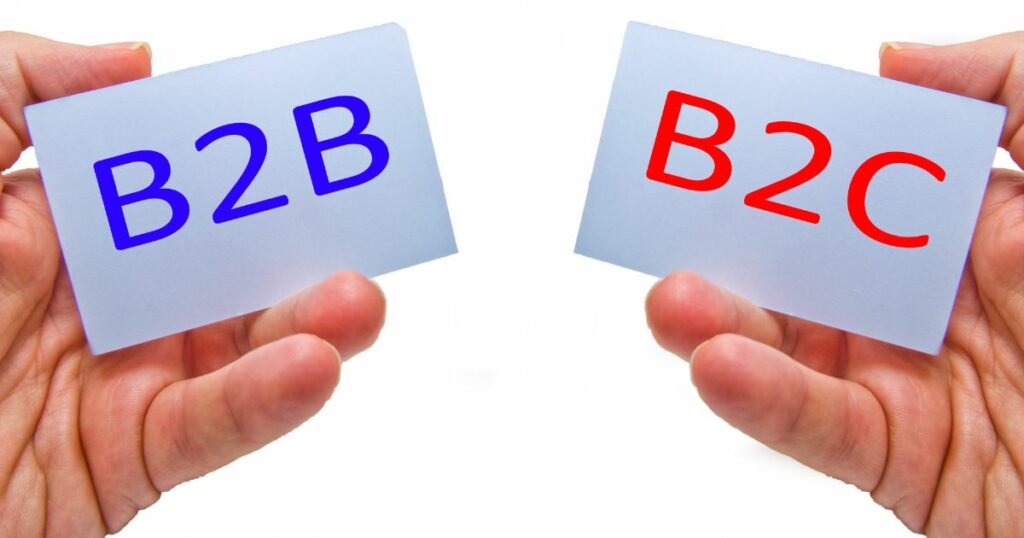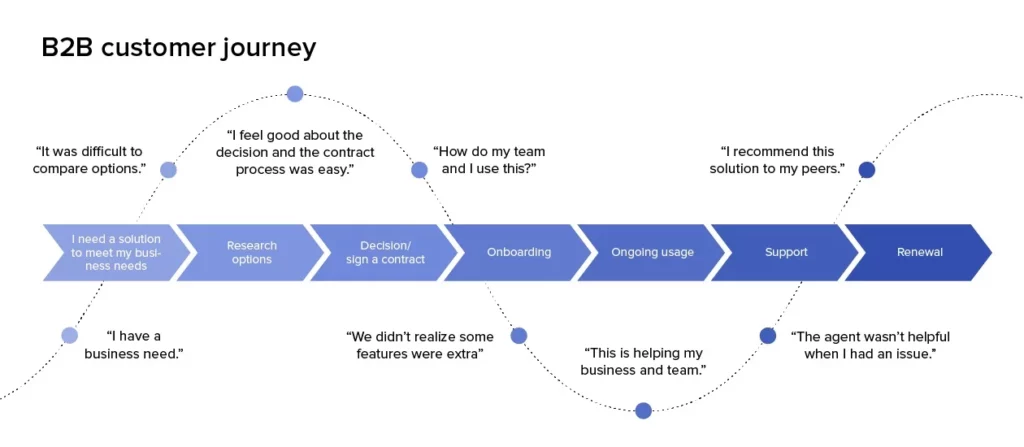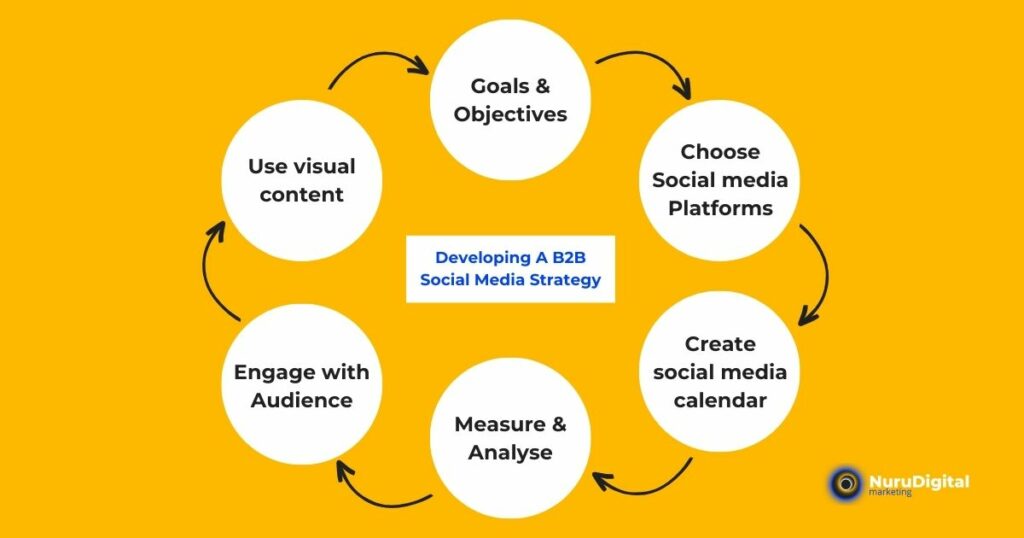Brian Tracy, a renowned business guru once said, “Your ability to communicate with your fellow human beings will be your greatest asset or your greatest liability.”
The statement has stirred us to discover that most businesses overlook this fact when it comes to selling to other businesses using social media.
B2B marketers struggle to effectively communicate with their target audience through social media but this doesn’t have to be the case.
Have you been pouring time and money into social media campaigns but they don’t yield the desired results?
Are you frustrated with the lack of engagement and ROI from your B2B social media strategy? If so, then grab a pen and paper and let me help you crack this riddle.
B2B social media strategy should be focused on building relationships, establishing credibility, and providing value to businesses.
How to create a winning B2B Social media Strategy
What is B2B social media marketing?

I figured we should just start at the top. B2B (Business to Business) social media marketing is when companies use social media platforms, like Facebook, Twitter, and LinkedIn, to promote their products and services to other businesses instead of individual customers.
This means that instead of trying to sell things to people like you and me, they are trying to sell things to other companies.
Unlike selling directly to consumers, this focuses on the business owners and major stakeholders. B2B social media marketers cannot rely on flashy posts that might go viral to close sales.
How is B2B Marketing Different from B2C

B2B social media strategy is focused on promoting products or services to other businesses. The goal is to generate leads, build relationships, and establish the company as a trusted industry leader. B2B companies often target decision-makers within organizations, such as executives or procurement managers.
Some common tactics used in B2B social media strategy include:
- Sharing educational or thought leadership content, such as white papers or case studies
- Engaging with followers and other businesses through comments, direct messages, or online communities
- Running targeted ads to reach specific industries or job titles
- Showcasing customer success stories or testimonials
On the other hand, B2C social media strategy is focused on promoting products or services directly to individual consumers. The goal is to drive sales, build brand awareness, and establish an emotional connection with the target audience.
Some common tactics used in B2C social media strategy include:
- Creating visually appealing content that is shareable and engaging
- Running influencer marketing campaigns to reach a wider audience
- Using social media as a customer service tool to respond to inquiries or concerns
- Showcasing customer reviews or testimonials
Why Having a B2B Social Media strategy is important?
Social media has taken center stage in the customer life cycle and aligning it with the overall business strategy is a call in the right direction. Here is why a B2B social media marketing strategy is important:
1. Increased brand awareness
Sharing relevant content and engaging prospects helps increase brand awareness and visibility. By regularly sharing content and engaging with followers, companies build their reputations and establish themselves as trusted industry leaders.
2. Lead generation
Social media can be an effective tool for generating leads and building relationships with potential clients. By sharing valuable content and engaging with prospects, businesses can attract and convert leads into loyal customers.
3. Improved customer relationships
Social media provides a platform for businesses to communicate directly with their customers and respond to their inquiries or concerns. By providing timely and helpful customer service, businesses can strengthen their relationships with existing clients and improve their overall satisfaction.
4. Thought leadership
By sharing industry insights and thought-provoking content, B2B companies can establish themselves as thought leaders in their respective fields. This can help build credibility and trust with potential clients and position the company as a go-to resource for industry knowledge.
This can be accomplished through a variety of tactics, such as creating blog posts, whitepapers, webinars, and social media posts that showcase your industry knowledge and expertise.
5. Competitive advantage
B2B social media marketing can help companies stand out from their competitors by showcasing their unique value proposition and highlighting their strengths. By regularly sharing success stories, case studies, and other relevant content, businesses can differentiate themselves and attract more customers.
6. Increased website traffic and SEO
Social media can also help drive traffic to a company’s website and improve its search engine rankings. By sharing blog posts and other content on social media, businesses can drive more traffic to their website and improve their SEO by creating backlinks.
What Are The Main Challenges With B2B Social Media Marketing?
The problem that many B2B marketers face is that they approach social media with the same tactics as B2C marketers.
They create flashy posts with the hope of going viral, rather than focusing on creating meaningful connections with their target audience.
B2B marketing requires a different approach because the sales cycle is longer and the decision-making process involves multiple stakeholders.
Therefore, B2B social media strategy should be focused on building relationships, establishing credibility, and providing value to the audience.
How to develop a B2B social media strategy that works?
We have experimented with a dozen clients and established two key areas to focus on. First, we focus on creating a content strategy that aligns with the buyer’s journey. Secondly, we purposely engage in social listening.
1) Mapping The Customer Journey
A customer journey map is a visual representation of the steps a customer takes before making a purchase.
It outlines the various pain points and experiences a customer may have with a business, from initial awareness to post-purchase.

Mapping a customer’s journey involves identifying their needs, problems and their reasons for engaging with your brand.
This involves identifying the pain points of your target audience and creating content that addresses those pain points at each stage of the buyer’s journey.
i. At the awareness stage, you can create blog posts or social media posts that educate your audience about industry trends and challenges.
ii. At the consideration stage, you can create white papers or case studies that showcase your company’s expertise and how you can solve the customer’s problems.
iii. Finally, at the decision stage, you can create product demos or webinars that demonstrate how your product or service can meet the customer’s specific needs.
Creating content that aligns with the buyer’s journey allows you to reach your audience at each stage of their decision-making process.
By addressing their pain points and providing valuable information, you can establish yourself as a thought leader in your industry and build trust with your target audience.
2) Engage in Social Listening
Social listening involves monitoring social media channels for mentions of your brand and industry keywords. It helps us identify customer pain points and engage in conversations with them.
Besides building relationships with potential customers, it also helps us gather valuable insights into customer needs and preferences.
Social listening allows your business to gain a better understanding of your target audience and tailor your content to their specific needs.
NB: Don’t miss out on the opportunity to grow your business through effective social media marketing. Contact us today to learn more about our digital marketing services and how we can help you achieve your marketing goals. Let’s work together to take your business to new heights!
The Steps involved In Developing A B2B Social Media Strategy
Consider the development of a B2B social media marketing strategy in light of these six steps;

I. Identify Your Goals and Objectives
Before creating any content, it’s important to define the companies you intend to engage or do business with. Your content is tailored to resonate with their core business practices and addresses their specific business needs.
It’s important to take into account not only your own business objectives but also the goals of your target audience. This includes understanding their specific needs and desires.
By providing content or offers that are valuable to them, you can maximize the effectiveness of your social media marketing efforts.
II. Choose The Right Social Media Platforms
It’s crucial to understand where your businesses are seeking to win clients online i.e. where their audience is spending their time on social media. This will help you determine which platforms they might be more interested to focus on.
For example, if your target audience consists of business professionals, LinkedIn may be the most effective platform to optimize and they need proof that you can actually funnel business for them from there.
On the other hand, if their target audience is comprised of the younger generation, Instagram or TikTok may be a better fit.
III. Create a Social Media Content Calendar
A social media content calendar helps you plan and organize your content in advance. This ensures that you are consistently publishing content that aligns with the overall marketing goals of the business. Planning in advance ensures you can guarantee these businesses value for their money because your content remains relevant to the target audience.
IV. Measure and Analyse Your Results
Business stakeholders recognize the need to closely monitor results and analyze data. It’s important to track and analyze their social media metrics to determine what is working and what isn’t. This gives them the confidence to make data-driven decisions and optimize to adapt, learn and grow their businesses.
V. Engage with your audience
Social media is a two-way conversation and B2B Social Media Marketing aims at fostering lasting relationships. It’s important to engage with your audience by responding promptly to interactions (comments and messages) in a professional manner. This helps build relationships and establish credibility with your partners.
VI. Use visual content
Visual content, like images, graphical representations, charts, and videos, is more likely to grab the attention of your business owners than text-only posts. The use of well-researched and informative visuals to showcase their brand and products is a point they might not afford to overlook.
Key Takeaways
- A well-executed B2B social media strategy will help your clients achieve their marketing goals and stand out from your competitors. Once you understand your target audience, you can create valuable content, engage with your followers, and track your results better.
- A B2B social media strategy is a powerful marketing tool for building brand awareness, generating leads, improving customer relationships, establishing thought leadership, and gaining a competitive advantage in the industry.
At Nuru Digital Marketing Agency we have extensive experience in developing and executing successful B2B social media marketing strategies for a variety of businesses. With our expertise and your vision, we can make magic happen.
If you’re interested in taking your B2B social media marketing to the next level, we encourage you to get in touch with us to discuss your marketing goals and how we can help you achieve them.


